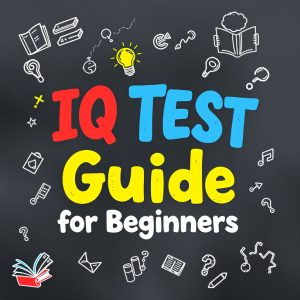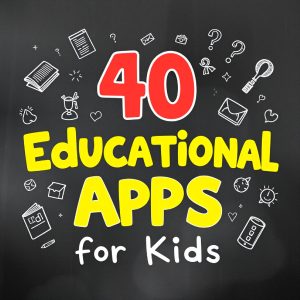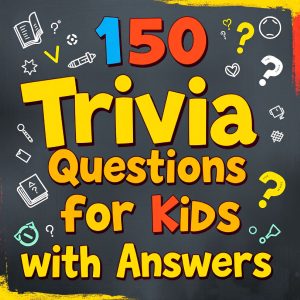When I was a kid, I loved solving riddles with my friends. It was so much fun trying to figure them out together. We would laugh and think hard, and that made our brains work better. Riddles helped us look at problems in new ways and think outside the box. They also made our playtime even more enjoyable.
In this article, I want to share some popular riddles for kids. These riddles will not only entertain your children but also help them learn and grow. Riddles encourage creativity and enhance critical thinking skills. Dive into this list of easy riddles for kids with answers and explaination and let your kids have fun while learning. Trust me, these riddles for kids will help you boost their minds in exciting ways!
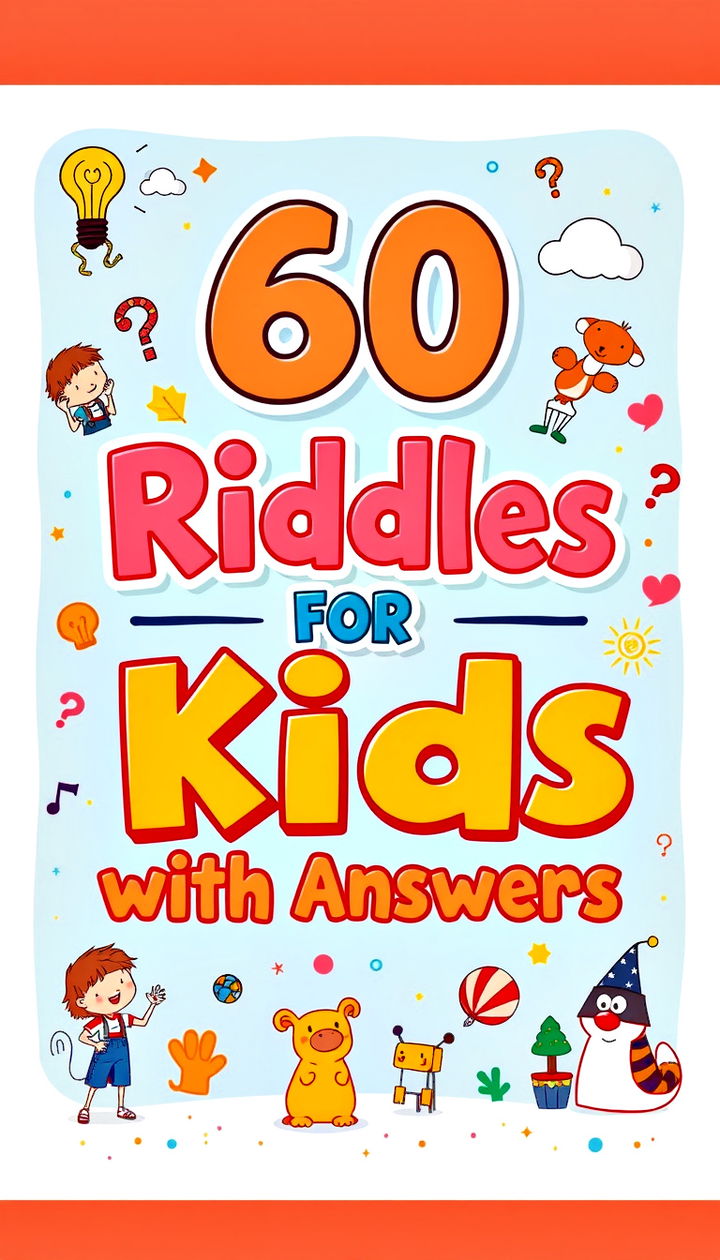
Riddle Categories by Kids Age:
I made a collection of super fun riddles for every age! I have easy riddles for little kids, trickier ones for older kids, and challenging ones for teens. Ready to dive in? Let’s go!
Easy Riddles for Younger Kids
Below are easy riddles for kids with answers great for preschool and early elementary kids. These riddles are simple but encourage young minds to think and use their imagination. They are designed to be easy to understand so younger children can enjoy solving them without getting frustrated.
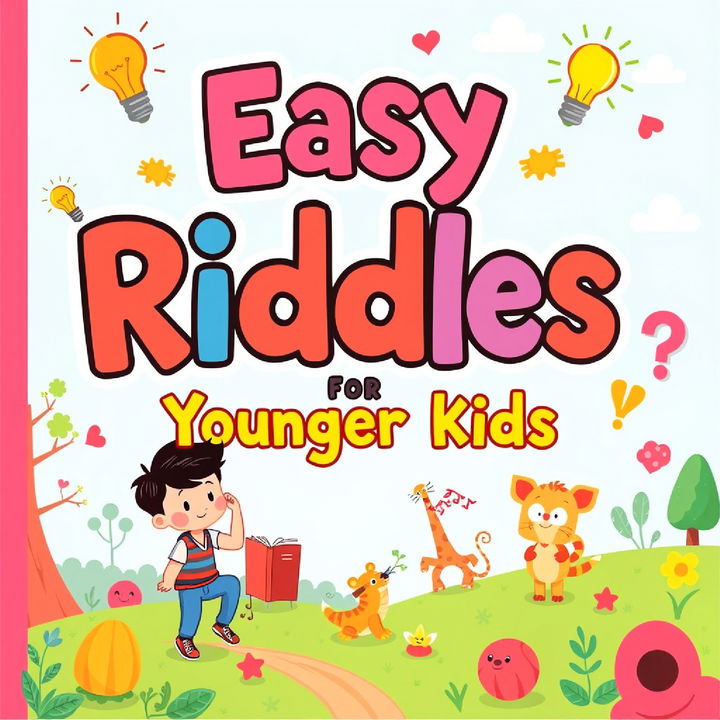
- Riddle: I’m tall when I’m young, and I’m short when I’m old. What am I?
Answer: A candle. Explanation: This riddle uses familiar objects like a candle, helping kids make connections and think about the properties of objects. - Riddle: What has keys but can’t open locks?
Answer: A piano. Explanation: This riddle helps kids understand that words can have different meanings, broadening their understanding of language. - Riddle: What has a face and two hands but no arms or legs?
Answer: A clock. Explanation: Uses personification to help kids develop abstract thinking skills by relating parts of the clock to body parts. - Riddle: What has to be broken before you can use it?
Answer: An egg. Explanation: Introduces the idea that sometimes things need to change form to be useful, in a very relatable way. - Riddle: What gets wetter as it dries?
Answer: A towel. Explanation: This riddle challenges kids to think about familiar objects in new and unexpected ways. - Riddle: What has one eye but can’t see?
Answer: A needle. Explanation: Teaches kids about parts of objects that are not alive but have human-like features. - Riddle: What has a thumb and four fingers but is not alive?
Answer: A glove. Explanation: Introduces kids to the concept of inanimate objects having human-like characteristics. - Riddle: What goes up but never comes down?
Answer: Your age. Explanation: Encourages kids to think about concepts that are abstract rather than physical objects. - Riddle: What begins with T, ends with T, and has T in it?
Answer: A teapot. Explanation: Helps kids understand that sometimes the answer lies in looking at things from different angles. - Riddle: What has an end but no beginning, a home but no family, and a space without room?
Answer: A keyboard. Explanation: Encourages kids to think about less obvious connections between objects and concepts. - Riddle: What month of the year has 28 days?
Answer: All of them. Explanation: Teaches kids about thinking beyond common assumptions and literal interpretations. - Riddle: What word is spelled wrong in every dictionary?
Answer: Wrong. Explanation: This playful language-based riddle helps kids understand wordplay and paradox. - Riddle: What can you catch but not throw?
Answer: A cold. Explanation: Makes kids think about the different meanings of “catch” and “throw.” - Riddle: What runs but never walks, has a mouth but never talks?
Answer: A river. Explanation: Gives kids a way to think about natural elements in a personified manner. - Riddle: I’m light as a feather, yet the strongest man can’t hold me for much longer than a minute. What am I?
Answer: Breath. Explanation: Provides a way for kids to think about their own bodies and abilities in a new way. - Riddle: What has a bed but never sleeps, can run but never walks, and has a bank but no money?
Answer: A river. Explanation: Helps kids make connections between different uses of the same word. - Riddle: What can travel around the world while staying in a corner?
Answer: A stamp. Explanation: Challenges kids to think about the function of objects rather than just their physical properties. - Riddle: What belongs to you but everyone else uses it more?
Answer: Your name. Explanation: Teaches kids about abstract ownership and the concept of names. - Riddle: What can be cracked, made, told, and played?
Answer: A joke. Explanation: Offers a fun way to understand different contexts in which words are used. - Riddle: What has a head, a tail, but no body?
Answer: A coin. Explanation: Helps kids learn about metaphors and thinking outside the box.
Have fun with these easy riddles and see your kids’ minds grow sharper!
Intermediate Riddles for Older Kids
These riddles are slightly more challenging and are designed to engage older children’s problem-solving skills, also best for elementary students. They require a bit more thought and consideration, making them perfect for kids who are ready for a challenge.
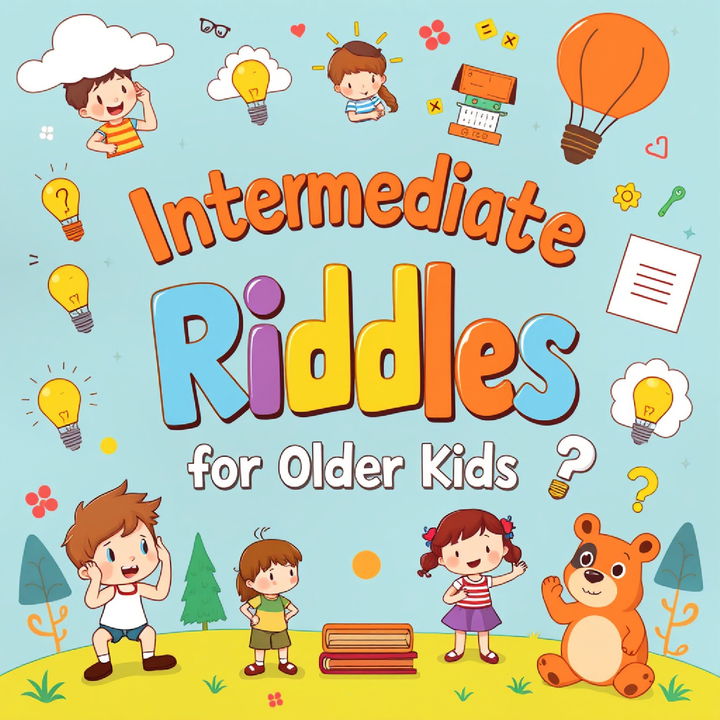
- Riddle: I speak without a mouth and hear without ears. I have no body, but I come alive with the wind. What am I?
Answer: An echo. Explanation: This riddle helps older kids think abstractly and understand that some things don’t need physical attributes to exist. - Riddle: You see a boat filled with people, yet there isn’t a single person on board. How is that possible?
Answer: All the people were married. Explanation: Encourages kids to interpret language creatively and understand that words can have different contextual meanings. - Riddle: I have branches, but no fruit, trunk, or leaves. What am I?
Answer: A bank. Explanation: This riddle makes kids think about the different meanings of common words. - Riddle: The more of this there is, the less you see. What is it?
Answer: Darkness. Explanation: Helps children think about conditions and abstract concepts rather than physical objects. - Riddle: I am not alive, but I can grow; I don’t have lungs, but I need air; I don’t have a mouth, but water kills me. What am I?
Answer: Fire. Explanation: Teaches kids about natural elements in a logical yet metaphorical manner. - Riddle: What can fill a room, but takes up no space?
Answer: Light. Explanation: Encourages older kids to think beyond physical dimensions and consider intangible elements. - Riddle: The more you take, the more you leave behind. What am I?
Answer: Footsteps. Explanation: This riddle helps kids think about cause and effect in a non-literal sense. - Riddle: What has many keys but can’t open a single lock?
Answer: A piano. Explanation: Reinforces understanding of words with multiple meanings and emphasizes critical thinking. - Riddle: What is black when it’s clean and white when it’s dirty?
Answer: A chalkboard. Explanation: Helps children think about transformations and changes rather than static states. - Riddle: I am taken from a mine and shut up in a wooden case, from which I am never released, and yet I am used by almost every person. What am I?
Answer: Pencil lead. Explanation: Encourages kids to think about everyday items and the process of how they are made or used. - Riddle: What begins with an “e” and only contains one letter?
Answer: An envelope. Explanation: Plays on understanding of word meanings and their different uses. - Riddle: I am always hungry, I must always be fed. The finger I touch, will soon turn red. What am I?
Answer: Fire. Explanation: Uses personification to help kids think about the characteristics of fire in a new way. - Riddle: What comes once in a minute, twice in a moment, but never in a thousand years?
Answer: The letter ‘M’. Explanation: Encourages kids to think about puzzles and the hidden meanings of words and letters. - Riddle: What travels around the world but stays in one spot?
Answer: A stamp. Explanation: Challenges kids to think about geographical movement in a non-literal way. - Riddle: What is so fragile that saying its name breaks it?
Answer: Silence. Explanation: Helps kids understand abstract concepts and the power of words. - Riddle: What has an eye but cannot see?
Answer: A needle. Explanation: Reinforces the idea that objects can have human-like features without being alive. - Riddle: You measure my life in hours and I serve you by expiring. I’m quick when I’m thin and slow when I’m fat. The wind is my enemy. What am I?
Answer: A candle. Explanation: Teaches kids about time, properties, and the effects of external factors. - Riddle: I have cities, but no houses; I have mountains, but no trees; I have water, but no fish. What am I?
Answer: A map. Explanation: Encourages older children to think about representations and symbols. - Riddle: What has a heart that doesn’t beat?
Answer: An artichoke. Explanation: Uses biological references in a way that makes kids think about non-living forms of “hearts.” - Riddle: What comes down but never goes up?
Answer: Rain. Explanation: Helps kids think about natural processes and the continuous cycle of certain elements.
These riddles challenge older kids, boosting their problem-solving and creativity!
Advanced Riddles for Teens
These riddles require more abstract thinking and are designed to enhance analytical abilities. They challenge teens to think deeply, solve complex problems, and use their reasoning skills in creative ways.
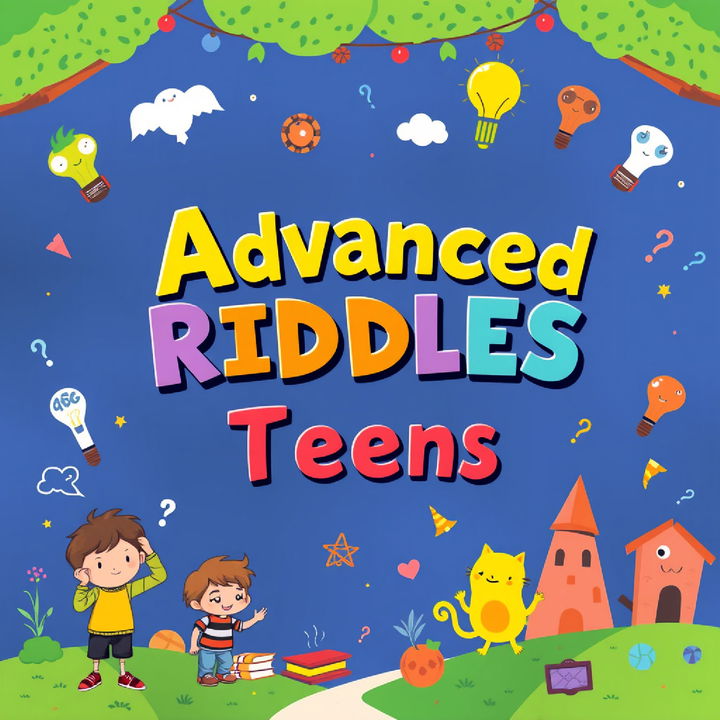
- Riddle: I am not alive, but I can die. What am I?
Answer: A battery. Explanation: This riddle helps teens think about non-living things that go through processes similar to living beings. - Riddle: I create my own light, but no one can turn me on. What am I?
Answer: The sun. Explanation: Encourages understanding of natural phenomena and their unique attributes. - Riddle: The person who makes it, sells it. The person who buys it never uses it, and the person who uses it never knows they are using it. What is it?
Answer: A coffin. Explanation: Requires abstract thinking and understanding of life cycles and roles. - Riddle: I have keys but no locks. I have space but no room. You can enter, but you can’t leave. What am I?
Answer: A keyboard. Explanation: Challenges teens to think about abstract representations and different contexts. - Riddle: What can run but never walks, has a mouth but never talks, has a head but never weeps, has a bed but never sleeps?
Answer: A river. Explanation: Encourages metaphorical thinking about natural elements. - Riddle: I can be cracked, made, told, and played. What am I?
Answer: A joke. Explanation: Helps teens think about the different ways one thing can be used or interpreted. - Riddle: I have cities but no houses, forests but no trees, and rivers but no water. What am I?
Answer: A map. Explanation: Enhances spatial thinking and understanding of abstract representations. - Riddle: I am taken from a mine, and shut up in a wooden case, from which I am never released, and yet I am used by almost everyone. What am I?
Answer: Pencil lead. Explanation: Encourages consideration of everyday objects and their uses. - Riddle: I am always in front of you but can’t be seen. What am I?
Answer: The future. Explanation: Helps teens think about time and abstract concepts. - Riddle: What comes once in a minute, twice in a moment, but never in a thousand years?
Answer: The letter “M”. Explanation: Encourages linguistic play and understanding of patterns. - Riddle: I have seas with no water, coasts with no sand, towns without people, mountains without land. What am I?
Answer: A map. Explanation: Promotes understanding of symbolic representation. - Riddle: I’m not alive, yet I can grow; I don’t have lungs, yet I need air; I don’t have a mouth, yet water kills me. What am I?
Answer: Fire. Explanation: Encourages metaphorical thinking and understanding of natural elements. - Riddle: What has to be broken before you can use it?
Answer: An egg. Explanation: Helps teens understand practical solutions and abstract reasoning. - Riddle: What can travel around the world while staying in a corner?
Answer: A stamp. Explanation: Encourages thinking about small objects with broad implications. - Riddle: I have keys that open no locks, yet I move from place to place. What am I?
Answer: A computer keyboard. Explanation: Helps teens think about familiar objects in technical terms. - Riddle: The more there is, the less you see. What is it?
Answer: Darkness. Explanation: Encourages thinking about conditions rather than tangible items. - Riddle: What is so delicate that saying its name breaks it?
Answer: Silence. Explanation: Helps teens think about abstract concepts and the power of language. - Riddle: I am always hungry and must always be fed. The finger I touch will soon turn red. What am I?
Answer: Fire. Explanation: Encourages understanding of natural phenomena and their attributes. - Riddle: I can only live where there is light, but I die if the light shines on me. What am I?
Answer: A shadow. Explanation: Enhances understanding of light and shadows, promoting abstract thinking. - Riddle: I have lakes with no water, mountains with no stone, and cities with no buildings. What am I?
Answer: A map. Explanation: Encourages understanding of abstract and symbolic thinking.
Enjoy these challenging riddles that boost teens’ problem-solving skills!
Popular Riddles for Kids: Tips for Solving Riddles
Riddles are a fun way to challenge your brain and think creatively! Here are some handy tips and strategies to help you solve riddles more easily.
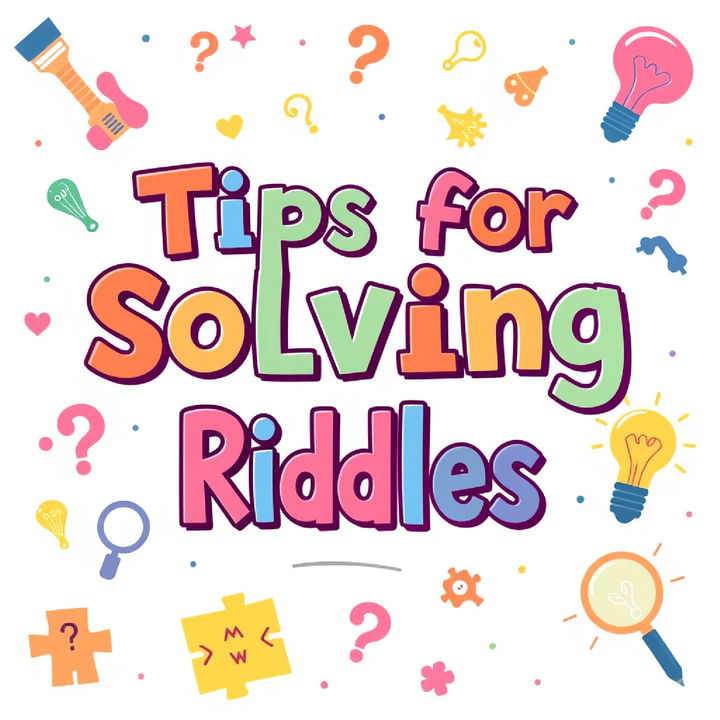
Look for Wordplay
Riddles often use clever wordplay or puns. Words might have double meanings or sound like other words. Pay close attention to the wording and think about any possible hidden meanings.
Example Riddle: What has keys but can’t open locks?
Strategy: Think about different meanings of the word “keys” other than keys for locks.
Solution: A piano! It has keys, but they are musical keys, not those used to open locks.
Think Outside the Box
Riddles rarely have straightforward answers. Be creative and try to come up with unconventional solutions. Sometimes the answer can be found by thinking about the riddle from a different perspective.
Example Riddle: I’m tall when I’m young, and I’m short when I’m old. What am I?
Strategy: Consider objects that change size over time. Visualizing different scenarios can help you find the answer.
Solution: A candle! It gets shorter as it burns.
Break Down the Riddle
Riddles can be tricky because they are often designed to confuse you. Break the riddle into smaller parts and analyze each part individually. This might help you see the connections more clearly.
Example Riddle: The more you take, the more you leave behind. What am I?
Strategy: Think individually about “the more you take” and “the more you leave behind.”
Solution: Footsteps! The more steps you take, the more footprints you leave behind.
Read the Riddle Aloud
Hearing the riddle might help you better understand it. Sometimes the way words sound can provide clues that are missed when reading silently.
Example Riddle: What has a head, a tail, is brown, and has no legs?
Strategy: Read it aloud and emphasize each word to see if it sparks any ideas.
Solution: A penny! It has a head and a tail (sides of the coin), is brown in color, and has no legs.
By using these strategies you can become a better riddle-solver. Try these tips next time you encounter a tricky riddle!
Benefits of Riddles for Children
Riddles are a fantastic tool for engaging and educating children, offering a wealth of cognitive, educational, and social benefits:
Cognitive Benefits:
- Enhanced Problem-Solving Skills: Riddles present children with challenges that require them to think critically and creatively. They learn to break down complex information, identify patterns, and apply logic to find solutions.
- Improved Memory and Concentration: Solving riddles often involves remembering details, clues, and wordplay, which exercises their memory and strengthens their ability to focus.
- Enhanced Critical Thinking: Riddles encourage children to analyze information, consider different perspectives, and evaluate possibilities, leading to improved critical thinking skills.
- Boosted Creativity and Imagination: The playful and open-ended nature of riddles stimulates children’s imagination and encourages them to think outside the box.
Educational Benefits:
- Expanded Vocabulary: Riddles often introduce children to new words and phrases, enriching their vocabulary and improving their language skills.
- Enhanced Reading Comprehension: Understanding the nuances and wordplay in riddles helps children develop better reading comprehension abilities.
- Improved Communication Skills: Discussing and explaining riddles with others promotes effective communication and strengthens their ability to articulate their thoughts.
Social Benefits:
- Teamwork and Collaboration: Solving riddles in groups fosters teamwork and cooperation as children brainstorm and share ideas to find solutions together.
- Strengthened Bonds: Sharing riddles and laughter creates fun and memorable experiences, strengthening relationships and promoting social bonding.
- Boosted Confidence and Self-Esteem: Successfully solving riddles provides a sense of accomplishment, boosting children’s confidence and self-esteem.
Riddles are a powerful tool for nurturing children’s cognitive, educational, and social development.
Making Riddles Part of Learning
Learn how to make riddles part of learning with fun themes for teaching and home below:
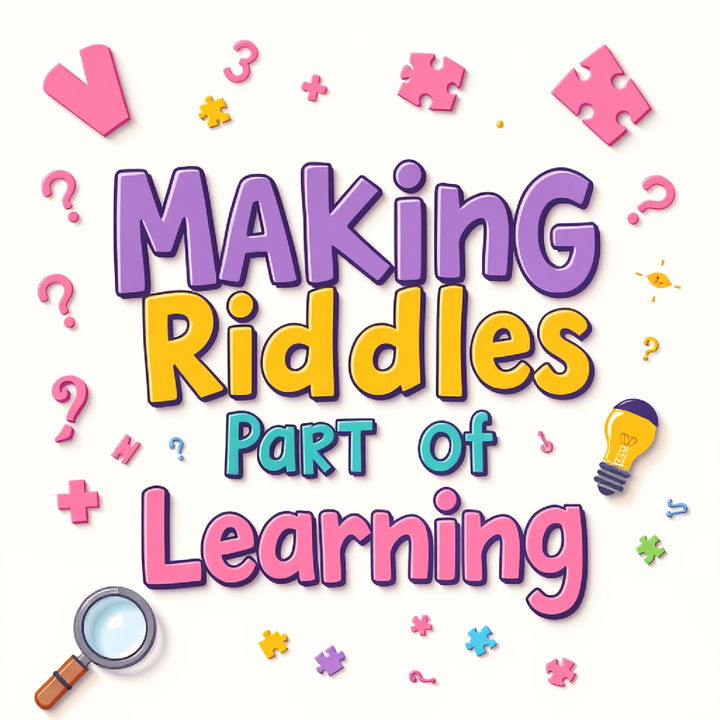
How to Use Riddles in Teaching and at Home
Here are some more detailed suggestions on how teachers and parents can weave riddles into their everyday activities to make learning more enjoyable and interactive:
- Warm-up Activities: Instead of diving straight into a lesson, kick things off with a riddle relevant to the topic. This helps capture students’ attention, stimulates their thinking, and creates a sense of anticipation for what’s to come.
- Brain Breaks: During long lessons or study sessions, introduce short riddle breaks to re-energize students and help them refocus. These quick mental challenges can improve concentration and boost overall productivity.
- Homework Fun: Make homework less of a chore by adding a few riddles at the end. This playful element can motivate students to complete their assignments and give them something to look forward to.
- Family Game Nights: Organize a family game night where riddles are the star attraction. You can create teams, keep scores, and even have small prizes to make it more exciting. It’s a great way to bond, have fun, and learn together.
- Road Trip Entertainment: Long car rides can get boring, but riddles can be a lifesaver! Prepare a list of age-appropriate riddles beforehand or encourage kids to come up with their own. It’s an excellent opportunity to spark conversation and keep everyone engaged.
- Classroom Challenges: Create a “Riddle of the Week” board where you post a new riddle every week. Students can submit their answers, and the first one to get it right gets a small reward or recognition.
- Story Time Enhancement: During story time, pause at certain points and ask kids to solve a riddle related to the plot or characters. This encourages active participation and deeper comprehension of the story.
- Outdoor Learning: When you’re out in nature, use riddles to draw attention to different plants, animals, or natural phenomena. This makes learning about the environment more interactive and memorable.
Riddle Themes to Try – Expanding the Fun
Here are some more detailed suggestions for themed riddle activities to make the learning experience even richer and more engaging:
- Holiday Riddles: Celebrate different holidays by using riddles that focus on their traditions, symbols, or historical significance. For example, you could have riddles about Santa Claus for Christmas, spooky creatures for Halloween, or the Easter Bunny for Easter.
- Nature Riddles: Explore the wonders of the natural world with riddles about animals, plants, weather patterns, and natural landmarks. This encourages kids to observe their surroundings, learn about different species, and appreciate the beauty of nature.
- Science Riddles: Ignite a passion for science with riddles that revolve around scientific concepts, inventions, famous scientists, or the human body. You can even create riddles about current scientific discoveries or space exploration missions to spark curiosity.
- Math Riddles: Make math less intimidating and more enjoyable by using riddles that involve numbers, shapes, patterns, or logical reasoning. This helps kids develop their problem-solving skills and see the practical applications of math in everyday life.
- Storybook Riddles: Bring beloved children’s books to life by creating riddles based on characters, plot points, or settings. This encourages kids to revisit their favorite stories, analyze details, and express their understanding in a creative way.
- Historical Riddles: Travel back in time with riddles about historical events, figures, or inventions. This is a fun way to learn about different periods in history and understand their impact on the world today.
- Geography Riddles: Explore different countries, continents, landmarks, or geographical features with riddles. This helps kids develop their knowledge of the world and appreciate its diversity.
Remember, the key is to tailor the riddles to the age and interests of the kids involved. Let them actively participate in the process by encouraging them to create and share their own riddles.
Conclusion
These riddles offer a wealth of benefits for children, promoting cognitive, educational, and social development. By incorporating riddles into learning and leisure activities, we can create engaging and enriching experiences that foster a lifelong love for learning and discovery. So, share riddles with your kids or students, and observe the positive outcomes as they develop critical thinking skills, creativity, and a sense of wonder.


